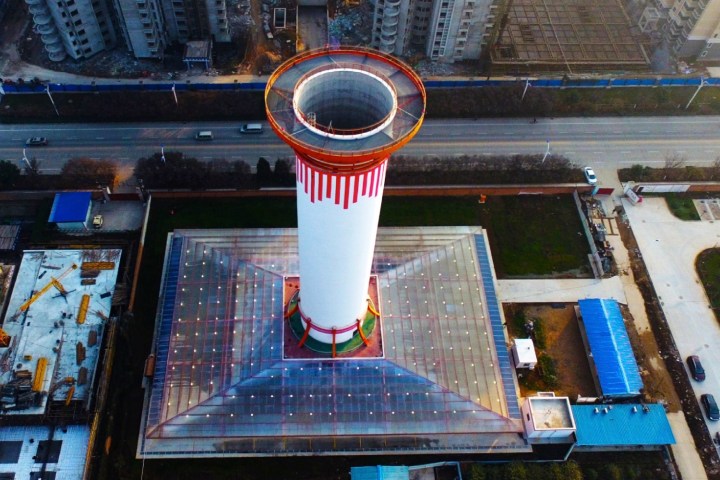China has a pretty severe pollution problem, with smog in some parts of the country so bad that it can discolor buildings and even blot out the sun. According to some estimates, high levels of air pollution in China’s cities cause up to 350,000 to 400,000 premature deaths each year. But a new project in Xi’an, one of the nation’s most severely polluted cities, aims to help — courtesy of an enormous 200-foot chimney. Unlike most chimneys, however, this one won’t add to the levels of air pollution, but rather act as an outdoor air purifying system, filtering out noxious particulate matter and blowing out clean air into the sky.
The chimney is designed to remove particles termed PM2.5, referring to particulate matter with an ultra-fine mass of less than 2.5 micrometers. This is known to be very dangerous to individuals and can increase age-specific mortality risk, particularly from cardiovascular causes.
“The Solar-Assisted Large-Scale Cleaning System (SALSCS) consists of a circular or rectangular based green house with glass panels that gradually rise toward the center tower,” Professor David Y.H. Pui, one of the researchers on the project, told Digital Trends. “Solar heating warms the polluted ambient air drawn in below the panels, and the warm air rises towards the center tower due to its buoyancy effect. A filter bank is placed around the tower entrance to remove the PM2.5 pollutants, so that only clean air exits the outlet on the top of the tower. By placing the SALSCS near a large city, it will pull the polluted air into the SALSCS and return the clean air to the city to reduce the PM2.5 concentration. The SALSCS glass panels are coated with nanoparticles to remove nitrogen oxides, one of the major precursors of PM2.5 and ozone.”
While results have yet to be published, the $2 million project has reportedly yielded positive results. Pui said that the project’s research group have found a 19 percent decrease in PM2.5 concentrations across a 10-square-kilometer area surrounding the Xi’an SALSCS, compared with other parts of the city.
“It took Los Angeles several decades to achieve today’s [levels of pollution in China by controlling the pollutants at their source,]” Pui continued. “It is likely that China can achieve it in a much shorter time due to available new technologies and the tightening of the emission standards. In a shorter term of 10-15 years, China can benefit from deploying the SALSCS technology for large scale cleaning of urban air pollution.”
Next up, Pui said the team hopes to build a much larger SALSCS in Xi’an, measuring a significantly bigger 1,000 feet. They also want to expand to other parts of China, as well as beyond.



